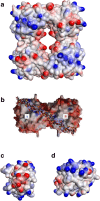Mast cell glycosaminoglycans
- PMID: 27900574
- PMCID: PMC5487770
- DOI: 10.1007/s10719-016-9749-0
Mast cell glycosaminoglycans
Abstract
Mast cells contain granules packed with a mixture of proteins that are released on degranulation. The proteoglycan serglycin carries an array of glycosaminoglycan (GAG) side chains, sometimes heparin, sometimes chondroitin or dermatan sulphate. Tight packing of granule proteins is dependent on the presence of serglycin carrying these GAGs. The GAGs of mast cells were most intensively studied in the 1970s and 1980s, and though something is known about the fine structure of chondroitin sulphate and dermatan sulphate in mast cells, little is understood about the composition of the heparin/heparan sulphate chains. Recent emphasis on the analysis of mast cell heparin from different species and tissues, arising from the use of this GAG in medicine, lead to the question of whether variations within heparin structures between mast cell populations are as significant as variations in the mix of chondroitins and heparins.
Keywords: Chondroitin; Dermatan; Glycosaminoglycan; Heparin; Mast cell; Serglycin.
Conflict of interest statement
Conflict of interest
The authors declare that they have no conflicts of interest.
Ethical approval
This article does not contain any studies with human participants or animals performed by any of the authors.
Figures




References
-
- Esko, J. D., Kimata, K., & Lindahl, U. 2009, Proteoglycans and Sulfated Glycosaminoglycans. In: Varki A. et al., eds. Essentials of Glycobiology, 2 ed. Pp. 219–248, Cold Spring Harbor Press (2009). - PubMed
Publication types
MeSH terms
Substances
Grants and funding
LinkOut - more resources
Full Text Sources
Other Literature Sources
Medical

